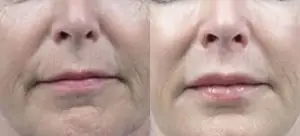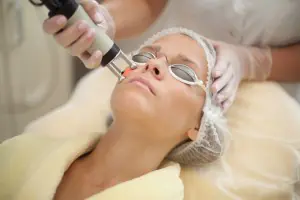We continue our series on skin diagnostics. In the last post we talked about 10 steps of competent diagnosis. And in this post we will talk in detail about oily skin: its signs, types, conditions, pros and cons.
Signs of oily facial skin
Thickness - oily skin is thick, dense, rough, textured.
Pores - expanded and large, clearly visible.
Comedones — there are closed and open comedones, often inflammation, subcutaneous tissue, milia.
Color - grayish, yellowish, pale skin, no blush, because blood circulation is slow.
Oily skin is also called seborrheic skin and is often hereditary. If everyone in your family has oily skin, don't be surprised where you get it.
Types of oily facial skin
Oily seborrheic skin is divided into two main subtypes and one subtype. They differ in the composition of sebum.
Liquid seborrhea. The composition of sebum is dominated by unsaturated fatty acids. The skin is greasy and shiny, like a buttered pancake. The pores are large, but shallow and empty. Fat flows freely from the pores without clogging them. There are no clogged pores or subcutaneous tissues on this type.
Thick seborrhea. The composition of sebum is dominated by saturated thick fatty acids. They tightly clog pores and create plugs, blackheads and subcutaneous areas. Comedones and inflammations of all kinds feel very comfortable on such skin and bloom in lush colors. The skin is thick and rough. Often it is matte and almost not greasy.
Mixed seborrhea. Particularly lucky people have mixed seborrhea. A greasy pancake, blackheads, subcutaneous skin and inflammation - all on one face.
Oily skin conditions
All types of oily skin can exist in several states.
- Broken epidermal barrier. On oily skin, dryness, hypersensitivity, discomfort, burning, itching, irritation, and red spots appear. Oily skin with a compromised barrier looks and feels dry. And this completely confuses us, we begin to treat the skin incorrectly and completely ruin everything.
Exception! Liquid seborrhea cannot have a damaged epidermal barrier. There are so many correct essential fatty acids that the lipid layer simply cannot collapse, they constantly feed it and patch up the gaps.
Dehydration. Yes, oily skin can be dehydrated. Easily. The elasticity of the skin decreases, sagging, tightness, wrinkles and folds appear. Dehydration can occur with any type of seborrhea. Because dehydration is a deficiency of moisture, not fat. Read more in this post.
Acne. If inflammation constantly appears on oily skin, it becomes oily and problematic. But oily skin is not always problematic.
It is important to understand the difference between skin type and skin condition.
- Oily skin (seborrhea) is a type.
- Thick, liquid, mixed - these are subtypes.
- And dehydration and disruption of the epidermal barrier are skin conditions.
- skin type is constant, rarely changes, usually with age;
- The skin condition is temporary.
Cons of oily skin
- Excessive greasiness, constantly shiny face.
- Clogged pores.
- Black dots.
- Inflammation.
- Acne, acne.
Most of the problems of oily skin - we are not taking into account serious acne now - are solved with well-chosen care. Read more in this post.
Pros of oily skin
Despite all the disadvantages, oily skin has one undoubted advantage - it is more resistant to environmental influences, it ages later, and wrinkles and folds appear on it much more slowly.
The main signs of oily skin are that it is dense, thick and rough, the pores are enlarged, the color is yellowish, there is no blush, there are comedones, blackheads and often rashes.
Oily skin is also called seborrhea and can be thick, thin or mixed.
Oily skin can be in different temporary states - dehydrated, with a broken epidermal barrier and acne.
Read about how to properly care for oily skin in a separate post.
Still have questions? Ask in the comments.
In the next post we will talk about dry skin. Improve your cosmetic literacy, stay with us and be beautiful.

Beautiful, fresh, glowing facial skin is the dream of every woman and many men. Some people get good skin from nature, while others spend a lot of time and money on cleansing, moisturizing and nourishing.
Skin types have long been defined, and each person can confidently say that he has one or another skin type: normal, dry, oily or combination. But there is a category of people who have a special type of skin - thick. This type is not sufficiently covered in the media, and its owners are often lost in the choice of skin care products and methods.
Features of thick skin
Thick skin is characterized by strong skin tension and a large layer of connective tissue, as well as increased work of the sebaceous glands.
Causes of thick skin formation:
- A person may have thick skin after burns and injuries with intensive development of connective tissue.
- Blood circulation problems can lead to increased skin density.
- Skin allergies that are frequent or persistent also lead to thickening of the skin.
- Endocrinopathy;
- Lymph flow disorders.
- Naturally oily skin. Thick skin is a type of oily skin, or more precisely, its subtype.
Thick skin is characterized by porosity and gloss, which is not removed even after washing. Such skin often has acne, which becomes very inflamed, and enlarged pores are closed with blackheads.
Thick leather has a number of advantages:
- strong greasy lubricant retains moisture, thanks to which the skin retains its youth for a long time;
- Wrinkles on thick skin appear much less frequently than on dry skin.
However, thick skin does not eliminate the hassle of care, but, on the contrary, increases it. Problems of porosity, acne, and red spots are difficult to solve for thick skin. In addition, thick skin makes facial movements difficult, which makes facial expressions comical. With age-related changes, thick skin begins to sag quickly, making the face look haggard.
Obviously, thick skin is a big aesthetic problem for many people.
Fractora technology for thick skin

To solve the problem of thick skin or seals on it, modern hardware cosmetology offers trouble-free effective method - Fractora. This technique was developed by Israeli scientists; it has already shown its effectiveness in solving problems of age-related changes. Fractora also copes with problems of thick skin with high efficiency.
The Fractora head uses fractional radiofrequency, which is delivered through multiple needle electrodes. The arsenal includes several different attachments, differing in the number of needle electrodes, with different coverage frequencies and different depths of impact.
The choice of attachment depends on the skin problems that need to be corrected. In addition to the dimensions of the electrodes and the area of influence, the doctor has the opportunity to select treatment parameters. These include speed and depth of impact, energy power.
Radiofrequency exposure gives the effect of ablation and heating, which together allows you to achieve maximum rejuvenating effect and correction of existing skin problems.
Thanks to radiofrequency exposure, the following is achieved:
- Alignment of skin texture;
- Firming effect;
- Lifting effect;
- Formation of clear contours;
- Elimination of pigmentation;
- Thickening of the skin.
Fractora procedure for thick skin
After a preliminary consultation, the doctor determines the treatment program for the skin. Thick skin is not just a problem in itself. It may have a number of additional problems: wrinkles, defects, unevenness, acne and post-acne.

In any case, for thick skin, electrodes with long needles are selected that penetrate deep into the subcutaneous layers. The skin treatment parameters are chosen to be medium or quite high, for this reason the rehabilitation period will be from 2 to 5 days.
The effect of the procedure is achieved quite quickly. For thick skin with high treatment parameters, 1-2 sessions are required at intervals of 4-5 weeks.
Before treatment, the skin is cleansed. For high and medium parameters, local anesthesia (emla) is used. Facial treatment usually lasts 15 to 20 minutes. After the procedure, the client feels intense warmth. There is skin redness and swelling. Crusts form at the contact points of the electrodes and peel off on their own.
Contraindications to the procedure:
- pregnancy and breastfeeding;
- oncological diseases;
- use of a pacemaker;
- exacerbation of chronic diseases;
- inflammatory processes in the body.
The effect of the Fractora procedure is observed after a few days and intensifies over time. The maximum result is achieved 1-2 months after the procedure:
- skin texture improves;
- pores narrow;
- the effect of sagging skin is eliminated;
- skin relief is leveled;
- skin tension disappears;
- the activity of the sebaceous glands is normalized.
The skin becomes more elastic, smooth, dense.
Fractora means glowing healthy skin and your self-confidence!
You can sign up for a free consultation with a specialist by calling: 8(495)545 15 10 O.N.I Aesthetic Medicine Clinic. clinic
Recommended reading
Popular articles
The success of a particular plastic surgery largely depends on how ... >>
Lasers in cosmetology are used for hair removal quite widely, so... >>
All women are advised to visit a gynecologist regularly. Often representatives of the beautiful... >>
It's no secret that Botox injections today... >>
A woman’s eyes are a reflection of her inner world. They express ... >>
In the modern world, many are faced with such an unpleasant phenomenon as... >>
The modern woman has learned to appreciate her body and realized that in ... >>



